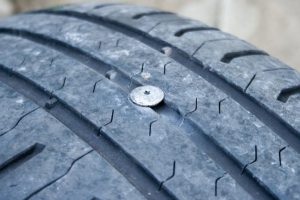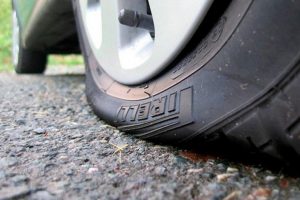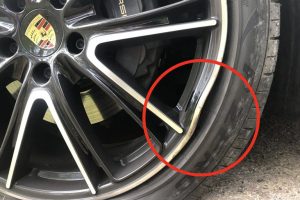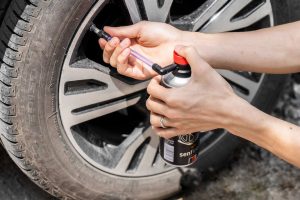If an automobile tire is slowly leaking air and not promptly fixed, it can lead to increased fuel consumption, and in severe cases, it may compromise safety during operation.
Early detection of tire leaks can help users avoid unwanted incidents. There are several reasons why a car tire may slowly lose air (deflate or go flat), such as tire wear over time, a faulty tire valve, or wheel rim bending or puncture.
Below are some guidelines that can help users address slowly leaking tire issues to ensure a safe journey. Typically, the resolution depends on the cause of the problem.
Caused by Sharp Objects Puncturing
When discovering a leak due to a sharp object puncture, it needs immediate attention. First, check the remaining air pressure in the tire to ensure it’s at the manufacturer’s recommended minimum pressure of 190 kPa (27 Psi).

If the pressure is insufficient, users should use a temporary air pump to reach the recommended pressure for their car according to the manufacturer. Then, proceed to a tire center to remove the object causing the puncture and repair the tire. Users can also do this at home if equipped with the necessary tire removal tools and specialized tire repair kit.
Faulty Tire Valve
If there are no visible objects around the tire surface causing the slow leak, users can suspect that the problem might stem from a damaged tire valve. Checking for a damaged valve is quite simple by applying a little diluted soapwater onto the valve head.

If there’s bubbling around the valve area, it’s almost certain the valve is damaged. Replacing the valve requires the expertise of tire technicians, and valve replacement costs are relatively low.
Wheel Rim Bending
If suspicion arises that the slow tire leak is due to a bent wheel rim, users can investigate by running their hand along the rim’s edge or applying soapy water spray around the contact area between the wheel rim and tire to identify the air escaping from the specific location.

In this case, users may find it difficult to fix the problem themselves and will likely need the intervention of a tire technician. They will realign any bent or distorted sections of the rim and seal the contact points between the tire and the rim using adhesive rim sealants.
In certain urgent situations, when facing tire problems in remote and hard-to-reach areas without access to a tire care center, users can opt for emergency self-vulcanizing tire sealant spray cans. These cans directly pump adhesive into the tire through the valve, helping to patch the air leak caused by the puncture.

It’s essential to note that this is a temporary solution useful for immediate use when a spare tire isn’t available and shouldn’t be used as a long-term solution. This measure assists drivers in reaching a safer location after a tire deflates or getting to the nearest car service center to receive assistance from tire experts.
Users should seek diagnosis and advice from tire shop experts or mobile tire repair services as early as possible to ensure their car’s tires remain in good condition and can function effectively for the long term












